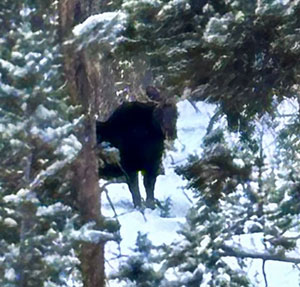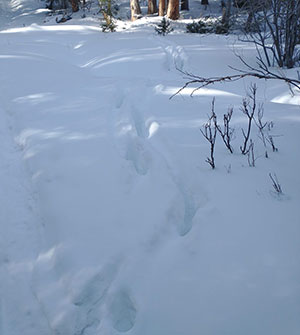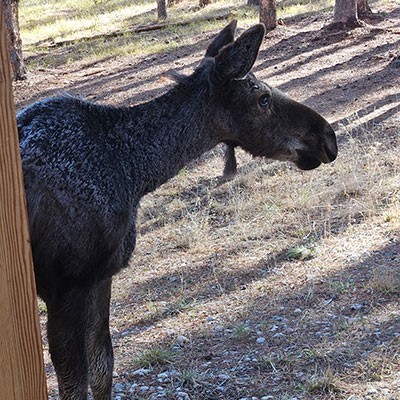No Slides Entered.
Five Moose Spotted During UW Biodiversity Institute’s Winter Moose Day Weekend
For the 11th year in a row, community scientists spotted moose and collected data about their populations in two mountains ranges outside of Laramie during Winter Moose Day weekend.
Eighty-one surveyors, traveling by snowshoes or skis, trekked 21 routes in the Snowy Range and Pole Mountain areas during the Feb. 8-9 event, which is coordinated, in part, by the University of Wyoming’s Biodiversity Institute.
Volunteers looked for moose or signs of moose, including tracks/hoofprints in snow, bed areas, scat droppings and browse on aspen and willows. In all, volunteers spotted five moose -- four adults and one calf.
The 2024 number was 12 -- 11 adults and one calf. The winter record sighting was in 2022 with 19 moose -- 15 adults and four calves.
Surveyors recorded visibility information, which includes sun coverage; snow coverage; visibility conditions; whether there were other recreationists encountered on the route; whether dogs were on the route; observations of live mammals, which included any animals larger than a chipmunk; and observations of dead mammals, which included a probable pronghorn and a probable moose, says Mason Lee, senior project coordinator of the Biodiversity Institute.
“If they spotted a live animal, they also recorded how they first saw the animal. Was it moving? Did it make a sound? Was the surveyor moving or still? How far away was the animal, etc.,” Lee says. “In addition to the moose, surveyors saw large groups of mule deer, as well as red squirrels and rabbits, of which the exact species is uncertain. The visibility conditions for this year’s Moose Day weekend were mostly perfect. Several large ungulate tracks were counted. Surveyors also incidentally reported that rabbit and small mammal tracks were very common.”
The 81 surveyors made up 34 different survey groups. Thirteen of the 17 routes in the Pole Mountain area were surveyed, and eight of 12 routes in the Snowy Range area were covered. Data was not collected on the one route in the Arlington area, Lee says.
Lee adds that 11 of the 21 routes were surveyed by more than one group -- a practice that was first used during the 2022 Summer Moose Day. Each year, surveyors are typically a mix of some volunteers who participate each year as well as newcomers.
“One survey group spotted a bull moose that still had its antlers. Even if surveyors did not spot moose or other mammals, several of them reported that it was a beautiful day and they had fun spending it outside for the survey,” Lee says. “I can say that the group that I went out with had a great morning finding rabbit and small mammal tracks, cool lichen and signs of moose browsing in the area. And we had fun snowshoeing among the willows and aspen.”
The data gathered from Winter Moose Day will be shared with biologists at UW. These biologists use the data collected by community scientists to further their understanding of the population densities of local moose, their reproductive rates, their winter ranges and how these variables change over time.
More information will be learned after Dave Christianson, an associate professor in the UW Department of Ecosystem Science and Management, and his graduate students analyze the Moose Day data as well as external factors that can affect moose counts, Lee says.
“Fundamental to understanding any animal is getting good information on its population. Moose are fundamentally rare. They don’t exist in large herds like mule deer and are sparser on the landscape than animals like cottontail rabbits,” Christianson said during volunteer training that took place before Winter Moose Day weekend. “So, observations of moose for management purposes can be hard to come by. But it’s a great species for studying with community scientists because we can deploy lots of people across the landscape at the same time to collect information of moose.”
Both the winter and summer Moose Day events are geared toward increasing the public’s understanding of moose in the Laramie area and involving the public in asking and answering questions. These events are an extension of the original program, Moose Day, held by Nature Mapping Jackson Hole (NMJH) in Jackson each winter. NMJH is a citizen science program created by the Jackson Hole Wildlife Foundation.
Share This Post

This moose was spotted in Middle Crow, located in the Pole Mountain area, by Bennet Hill during Winter Moose Day weekend Feb. 8-9. Community scientists spotted four adult moose and one calf in the Snowy Range and Pole Mountain areas during the event. Winter Moose Day is coordinated, in part, by the University of Wyoming’s Biodiversity Institute. (Tiernan Mcllwaine Photo)

These suspected large ungulate tracks were spotted in the North Fork of the Little Laramie area in the Centennial Valley during the recent Winter Moose Day weekend. (Jason McMahan Photo)
Social Media
Latest News



Archives
- All
- October 2025
- August 2025
- July 2025
- June 2025
- May 2025
- April 2025
- March 2025
- February 2025
- January 2025
- November 2024
- October 2024
- September 2024
- August 2024
- July 2024
- June 2024
- May 2024
- April 2024
- March 2024
- February 2024
- January 2024
- December 2023
- November 2023
- August 2023
- July 2023
- April 2023
- September 2022
- August 2022
- July 2022
- June 2022
- May 2022
- April 2022
- March 2022
- February 2022
- January 2022
- December 2021
- November 2021
- October 2021
- September 2021
- August 2021
- May 2021
- April 2021
- March 2021
- October 2020
- August 2020
- July 2020
- January 2020
- March 2019

